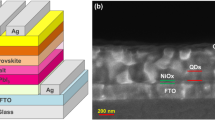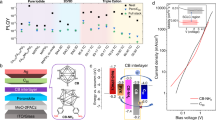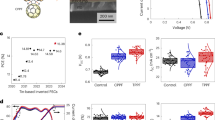Abstract
To improve the efficiency of perovskite solar cells, careful device design and tailored interface engineering are needed to enhance optoelectronic properties and the charge extraction process at the selective electrodes. Here, we use two-dimensional transition metal carbides (MXene Ti3C2Tx) with various termination groups (Tx) to tune the work function (WF) of the perovskite absorber and the TiO2 electron transport layer (ETL), and to engineer the perovskite/ETL interface. Ultraviolet photoemission spectroscopy measurements and density functional theory calculations show that the addition of Ti3C2Tx to halide perovskite and TiO2 layers permits the tuning of the materials’ WFs without affecting other electronic properties. Moreover, the dipole induced by the Ti3C2Tx at the perovskite/ETL interface can be used to change the band alignment between these layers. The combined action of WF tuning and interface engineering can lead to substantial performance improvements in MXene-modified perovskite solar cells, as shown by the 26% increase of power conversion efficiency and hysteresis reduction with respect to reference cells without MXene.
This is a preview of subscription content, access via your institution
Access options
Access Nature and 54 other Nature Portfolio journals
Get Nature+, our best-value online-access subscription
$29.99 / 30 days
cancel any time
Subscribe to this journal
Receive 12 print issues and online access
$259.00 per year
only $21.58 per issue
Buy this article
- Purchase on Springer Link
- Instant access to full article PDF
Prices may be subject to local taxes which are calculated during checkout





Similar content being viewed by others
Data availability
The experimental data that support the findings of this study are available from the corresponding author upon reasonable request.
Code availability
The Quantum Espresso scripts for DFT calculation and TiberCad scripts for device simulations that support the findings of this study are available from the corresponding authors upon reasonable request.
Change history
14 October 2019
An amendment to this paper has been published and can be accessed via a link at the top of the paper.
References
Cai, M. et al. Cost-performance analysis of perovskite solar modules. Adv. Sci. 4, 1600269 (2016).
Hussain, I. et al. Functional materials, device architecture, and flexibility of perovskite solar cell. Emergent Mater. 1, 133–154 (2018).
Kim, H.-S., Hagfeldt, A. & Park, N.-G. Morphological and compositional progress in halide perovskite solar cells. Chem. Commun. 55, 1192–1200 (2019).
Ameen, S., Akhtar, M. S., Shin, H.-S. & Nazeeruddin, M. K. Charge-transporting materials for perovskite solar cells. Adv. Inorg. Chem 72, 185–246 (2018).
Fakharuddin, A. et al. Perovskite-polymer blends influencing microstructures, nonradiative recombination pathways, and photovoltaic performance of perovskite solar cells. ACS Appl. Mater. Interfaces 10, 42542–42551 (2018).
Mingorance, A. et al. Interfacial engineering of metal oxides for highly stable halide perovskite solar cells. Adv. Mater. Interfaces 1800367, 1–10 (2018).
You, P., Tang, G. & Yan, F. Two-dimensional materials in perovskite solar cells. Mater. Today Energy 11, 128–158 (2019).
Li, T. et al. Additive engineering for highly efficient organic-inorganic halide perovskite solar cells: recent advances and perspectives. J. Mater. Chem. A 5, 12602–12652 (2017).
Chen, K., Schünemann, S., Song, S. & Tüysüz, H. Structural effects on optoelectronic properties of halide perovskites. Chem. Soc. Rev. 47, 7045–7077 (2018).
Yang, S., Fu, W., Zhang, Z., Chen, H. & Li, C. Z. Recent advances in perovskite solar cells: efficiency, stability and lead-free perovskite. J. Mater. Chem. A 5, 11462–11482 (2017).
Isabelli, F. et al. Solvent systems for industrial-scale processing of Spiro-OMeTAD hole transport layer in perovskite solar cells. ACS Appl. Energy Mater. 1, 6056–6063 (2018).
Wang, Z. K. & Liao, L. S. Doped charge-transporting layers in planar perovskite solar cells. Adv. Opt. Mater. 6, 1–13 (2018).
Courtier, N. E., Cave, J. M., Foster, J. M., Walker, A. B. & Richardson, G. How transport layer properties affect perovskite solar cell performance: insights from a coupled charge transport/ion migration model. Energy Environ. Sci. 12, 396–409 (2019).
Fakharuddin, A., Schmidt-Mende, L., Garcia-Belmonte, G., Jose, R. & Mora-Sero, I. Interfaces in perovskite solar cells. Adv. Electron. Mater 7, 1–44 (2017).
Wang, S., Sakurai, T., Wen, W. & Qi, Y. Energy level alignment at interfaces in metal halide perovskite solar cells. Adv. Mater. Interfaces 5, 1–30 (2018).
Saidaminov, M. I. et al. Suppression of atomic vacancies via incorporation of isovalent small ions to increase the stability of halide perovskite solar cells in ambient air. Nat. Energy 3, 648–654 (2018).
Lee, I., Yun, J. H., Son, H. J. & Kim, T. S. Accelerated degradation due to weakened adhesion from Li-TFSI additives in perovskite solar cells. ACS Appl. Mater. Interfaces 9, 7029–7035 (2017).
Agresti, A. et al. Graphene interface engineering for perovskite solar modules: 12.6% power conversion efficiency over 50 cm2 active area. ACS Energy Lett. 2, 279–287 (2017).
Petridis, C., Kakavelakis, G. & Kymakis, E. Renaissance of graphene-related materials in photovoltaics due to the emergence of metal halide perovskite solar cells. Energy Environ. Sci. 11, 1030–1061 (2018).
Taheri, B. et al. Graphene-engineered automated sprayed mesoscopic structure for perovskite device scaling-up. 2D Mater. 5, 045034 (2018).
Arora, N. et al. Perovskite solar cells with CuSCN hole extraction layers yield stabilized efficiencies greater than 20%. Science 358, 768–771 (2017).
Konios, D. et al. Highly efficient organic photovoltaic devices utilizing work-function tuned graphene oxide derivatives as the anode and cathode charge extraction layers. J. Mater. Chem. A 4, 1612–1623 (2016).
Agresti, A. et al. Efficiency and stability enhancement in perovskite solar cells by inserting lithium-neutralized graphene oxide as electron transporting layer. Adv. Funct. Mater. 26, 2686–2694 (2016).
Agresti, A. et al. Two-dimensional (2D) material interface engineering for efficient perovskite large-area modules. ACS Energy Lett. 4, 1862–1871 (2019).
Najafi, L. et al. MoS2 quantum dot/graphene hybrids for advanced interface engineering of a CHNH3PbI3 perovskite solar cell with an efficiency of over 20%. ACS Nano 12, 10736–10754 (2018).
Hantanasirisakul, K. & Gogotsi, Y. Electronic and optical properties of 2D transition metal carbides and nitrides (MXenes). Adv. Mater. 1804779, 1–30 (2018).
Naguib, M., Mochalin, V. N., Barsoum, M. W. & Gogotsi, Y. 25th anniversary article: MXenes: a new family of two-dimensional materials. Adv. Mater. 26, 992–1005 (2013).
Zhang, C. J. et al. Transparent, flexible, and conductive 2D titanium carbide (MXene) films with high volumetric capacitance. Adv. Mater. 29, 1–9 (2017).
Lipatov, A. et al. Elastic properties of 2D Ti3C2Tx MXene monolayers and bilayers. Sci. Adv. 4, eaat0491 (2018).
Akuzum, B. et al. Rheological characteristics of 2D titanium carbide (MXene) dispersions: a guide for processing MXenes. ACS Nano 12, 2685–2694 (2018).
Khazaei, M., Ranibar, A., Arai, M., Sasaki, T. & Yunoki, S. Electronic properties and application of MXenes: a theoretical review. J. Mater. Chem. C. 5, 2488–2503 (2017).
Khazaei, M. et al. OH-terminated two-dimensional transition metal carbides and nitrides as ultralow work function materials. Phys. Rev. B. 92, 1–10 (2015).
Hu, T. et al. Chemical origin of termination-functionalized MXenes: Ti3C2T2 as a case study. J. Phys. Chem. C 121, 19254–19261 (2017).
Liu, Y., Xiao, H. & Goddard, W. A. Schottky-barrier-free contacts with two-dimensional semiconductors by surface-engineered MXenes. J. Am. Chem. Soc. 138, 15853–15856 (2016).
Schultz, T. et al. Surface termination dependent work function and electronic properties of Ti3C2Tx MXene. Chem. Mater. https://doi.org/10.1021/acs.chemmater.9b00414 (2019).
Yu, Z. et al. MXenes with tunable work functions and their application as electron- and hole-transport materials in non-fullerene organic solar cells.J. Mater. Chem. A. 7, 11160–11169 (2019).
Fu, H. C. et al. MXene-contacted silicon solar cells with 11.5% efficiency. Adv. Energy Mater. 1900180, 1–9 (2019).
Dall’Agnese, C., Dall’Agnese, Y., Anasori, B., Sugimoto, W. & Mori, S. Oxidized Ti3C2 MXene nanosheets for dye-sensitized solar cells. New J. Chem. 42, 16446–16450 (2018).
Guo, Z. et al. High electrical conductivity 2D MXene serves as additive of perovskite for efficient solar cells. Small 1802738, 1–8 (2018).
Yang, L. et al. SnO2-Ti3C2 MXene electron transport layers for perovskite solar cells. J. Mater. Chem. A. 7, 5635–5642 (2019).
Peng, C. et al. High efficiency photocatalytic hydrogen production over ternary Cu/TiO2@Ti3C2T2 enabled by low-work-function 2D titanium carbide. Nano Energy 53, 97–107 (2018).
Deng, W. et al. All-sprayed-processable, large-area, and flexible perovskite/MXene-based photodetector arrays for photocommunication. Adv. Opt. Mater. 1801521, 1–9 (2019).
Philippe, B. et al. Valence level character in a mixed perovskite material and determination of the valence band maximum from photoelectron spectroscopy: variation with photon energy. J. Phys. Chem. C. 121, 26655–26666 (2017).
Ahn, N. et al. Trapped charge-driven degradation of perovskite solar cells. Nat. Commun. 7, 1–9 (2016).
Auf Der Maur, M. et al. The multiscale paradigm in electronic device simulation.IEEE Trans. Electron Devices 58, 1425–1432 (2011).
Deepa, M. et al. Cesium power: low Cs+ levels impart stability to perovskite solar cells. Phys. Chem. Chem. Phys. 19, 4069–4077 (2017).
Sarycheva, A. et al. Two-dimensional titanium carbide (MXene) as surface-enhanced Raman scattering substrate. J. Phys. Chem. C. 121, 19983–19988 (2017).
Chaudhuri, K. et al. Highly broadband absorber using plasmonic titanium carbide (MXene). ACS Photonics 5, 1115–1122 (2018).
Alhabeb, M. et al. Guidelines for synthesis and processing of two-dimensional titanium carbide (Ti3C2Tx MXene). Chem. Mater. 29, 7633–7644 (2017).
Ghidiu, M., Lukatskaya, M. R., Zhao, M.-Q., Gogotsi, Y. & Barsoum, M. W. Conductive two-dimensional titanium carbide ‘clay’ with high volumetric capacitance. Nature 516, 78–81 (2014).
Acknowledgements
A.D.C. and D.S. gratefully acknowledge the financial support from the Ministry of Education and Science of the Russian Federation in the framework of MegaGrant (no. 075-15-2019-872 (14.Y26.31.0027/074-02-2018-327)). A.A. and S.P. gratefully acknowledge funding from the European Union’s Horizon 2020 Research and Innovation Program (grant agreement no. 785219-GrapheneCore2).
Author information
Authors and Affiliations
Contributions
A. Pazniak, A.D.C., D.S. and D.V.K. conceived the work. A.A. and S.P. performed the experiments on solar cells and the electro-optical characterizations. A. Pazniak produced and characterized the MXenes. A.D.V., D.R., A. Pecchia and M.A. performed the theoretical simulations. R.L. and A.L. performed UPS. A.D.C. coordinated the research activity. The manuscript was written with contributions from all the authors. All the authors approved the final version of the manuscript.
Corresponding author
Ethics declarations
Competing interests
The authors declare no competing interests.
Additional information
Publisher’s note: Springer Nature remains neutral with regard to jurisdictional claims in published maps and institutional affiliations.
Supplementary information
Supplementary Information
Supplementary Figs. 1–25, Table 1, acknowledgements and Refs. 1–30.
Rights and permissions
About this article
Cite this article
Agresti, A., Pazniak, A., Pescetelli, S. et al. Titanium-carbide MXenes for work function and interface engineering in perovskite solar cells. Nat. Mater. 18, 1228–1234 (2019). https://doi.org/10.1038/s41563-019-0478-1
Received:
Accepted:
Published:
Issue Date:
DOI: https://doi.org/10.1038/s41563-019-0478-1
This article is cited by
-
Performance simulation of the perovskite solar cells with Ti3C2 MXene in the SnO2 electron transport layer
Scientific Reports (2024)
-
Solar Cell Efficiency Enhancement Via Mulberry Molasses-Based Carbon Quantum Dot-Supported CdS and CdS-Mn Nanomaterials
Waste and Biomass Valorization (2024)
-
Performance enhancement of organic perovskite solar cell with graphene oxide as electron transport layer
Journal of Optics (2024)
-
Modification of the Properties of Titanium Carbide MXene by Ag Doping via Ion Implantation for Quantum Dot-Sensitized Solar Cell Applications
Journal of Electronic Materials (2024)
-
Printed transistors made of 2D material-based inks
Nature Reviews Materials (2023)



